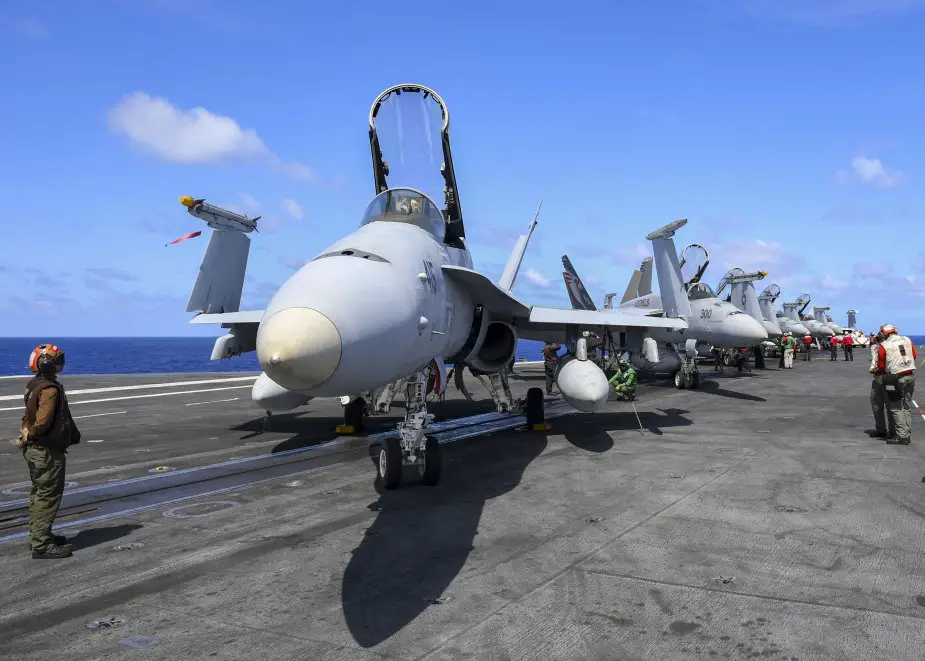Breaking news
USS Theodore Roosevelt, Nimitz Carrier Strike Groups operate together in 7th Fleet.
The USS Theodore Roosevelt (CVN 71) and USS Nimitz (CVN 68) strike groups commenced dual carrier flight operations in the Philippine Sea on June 21. The ships and aircraft assigned to both strike groups began coordinated operations in international waters demonstrating the United States’ unique capability to operate multiple carrier strike groups in close proximity.
Follow Navy Recognition on Google News at this link

Philippine Sea, June 17, 2020. An E/A-18G Growler assigned to the Gray Wolves of Electronic Attack Squadron (VAQ) 142 launches from the flight deck of the aircraft carrier USS Theodore Roosevelt (CVN 71), June 17, 2020. The Theodore Roosevelt Carrier Strike Group is on a scheduled deployment to the Indo-Pacific (Picture source: U.S. Navy/Mass Communication Specialist 3rd Class Zachary Wheeler)
While at sea, the strike groups will support air defense drills, sea surveillance, replenishments at sea, defensive air combat training, long-range strikes, coordinated maneuvers and other exercises. “This is a great opportunity for us to train together in a complex scenario,” said Rear Adm. Doug Verissimo, commander of Carrier Strike Group (CSG) 9. “By working together in this environment, we’re improving our tactical skills and readiness in the face of an increasingly pressurized region and COVID-19.”
As a Pacific nation and a Pacific leader, the United States has a national interest in maintaining security and prosperity, peaceful resolution of disputes, unimpeded lawful commerce, and adherence to freedom of navigation and overflight throughout the shared domains of the Indo-Pacific. For more than 75 years, the U.S. Navy has been a persistent and stabilizing presence conducting operations throughout the region on a daily basis. “The United States Navy has a long history of operating multiple carrier strike groups as a combined force in the Pacific,” said Rear Adm. James Kirk, commander of Carrier Strike Group (CSG) 11. “Our operations demonstrate the resilience and readiness of our naval force and are a powerful message of our commitment to regional security and stability as we protect the critically important rights, freedoms, and lawful uses of the sea for the benefit of all nations.”
U.S. Navy aircraft carriers have conducted dual carrier strike group operations in the Western Pacific including the South China Sea, East China Sea and Philippine Sea for several years. These operations typically occur when strike groups deployed to the 7th Fleet area of operations from the West Coast of the United States are joined with the forward-deployed carrier strike group from Japan.
CSG 11 consists of the aircraft carrier USS Nimitz (CVN 68), guided-missile cruiser USS Princeton (CG 53) and guided-missile destroyers of Destroyer Squadron (DESRON) 9, which includes USS Sterett (DDG 104), USS Ralph Johnson (DDG 114) and Carrier Air Wing (CVW) 17.
CSG 9 consists of the aircraft carrier USS Theodore Roosevelt (CVN 71), guided-missile cruiser USS Bunker Hill (CG 53) and guided-missile destroyers from Destroyer Squadron (DESRON) 23, USS Russell (DDG 59), USS Rafaela Peralta (DDG 115), and Carrier Air Wing (CVW) 11.
USS Theodore Roosevelt departed San Diego on January 17, 2020, for a scheduled Indo-Pacific deployment while Nimitz departed on June 8.

Pacific Ocean, (June 12, 2020. Sailors assigned to the Nimitz Carrier Strike Group perform preflight checks on aircraft aboard the aircraft carrier USS Nimitz (CVN 68). Nimitz, the flagship of Carrier Strike Group 11, is deployed conducting maritime security operations and theater security cooperation efforts (Picture source: U.S. Navy/Mass Communication Specialist 2nd Class Greg Hall)
Carrier strike group
A carrier strike group (CSG) is an operational formation of the United States Navy. It is composed of roughly 7,500 personnel, an aircraft carrier, at least one cruiser, a destroyer squadron of at least two destroyers or frigates, and a carrier air wing of 65 to 70 aircraft. A carrier strike group also, on occasion, includes submarines, attached logistics ships and a supply ship. The carrier strike group commander operationally reports to the commander of the numbered fleet, who is operationally responsible for the area of waters in which the carrier strike group is operating.
Strike groups comprise a principal element of U.S. power projection capability; a single supercarrier holds enough firepower to rival the air forces of entire nations. Previously referred to as carrier battle groups (a term still used by other nations), they are often referred to by the carrier they are associated with (e.g., Enterprise Strike Group). As of March 2016, there were 10 carrier strike groups in the U.S. Navy.
The carrier strike group is a flexible naval force that can operate in confined waters or in the open ocean. The principal role of the carrier and its air wing within the carrier strike group is to provide the primary offensive firepower, while the other ships provide defense and support. These roles are not exclusive, however. Other ships in the strike group sometimes undertake offensive operations (launching cruise missiles, for instance) and the carrier's air wing contributes to the strike group's defense (through combat air patrols and airborne anti-submarine efforts). Thus, from a command and control perspective, carrier strike groups are combat organized by mission rather than by platform.


























